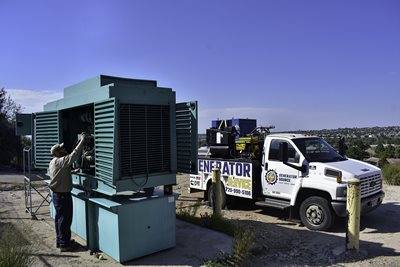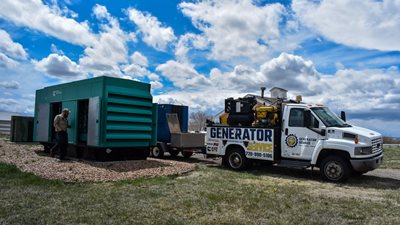Organizations with remote work forces should continue to maintain generators and other facility assets
With
COVID-19 cases on the rise in counties across Colorado, many businesses are electing to reverse facility reoccupation plans and continue work from home policies. While these decisions are necessary to protect employee health and welfare, they present a conundrum for maintaining the critical equipment that will be needed when workers reoccupy facilities post-COVID. Facilities engineers and maintenance teams should deliberately take steps to ensure that backup generators are maintained while other employees are working remotely.
Diesel generators provide redundant power for facilities, ensuring that critical systems are available even during a power outage. These generators consist of an industrial engine, generator end, controls, and supporting equipment. Diesel engines are highly reliable but require regular maintenance to ensure that they can provide their states capability at a moment’s notice.
Schedule generator tests
 The first step that maintenance teams can take to ensure their generator’s readiness is to schedule tests for their generator. Also known as “exercising the generator”, regular tests allow the machinery to lubricate itself, turn over critical parts, and update any faults on the control panel. While facilities teams should consult their generator manuals for equipment specific requirements, most generator tests occur weekly or monthly. Most facilities exercise their generator without connecting it to the building’s actual load (called “no load), while others will incorporate their automatic transfer switch (ATS) to truly simulate an outage.
The first step that maintenance teams can take to ensure their generator’s readiness is to schedule tests for their generator. Also known as “exercising the generator”, regular tests allow the machinery to lubricate itself, turn over critical parts, and update any faults on the control panel. While facilities teams should consult their generator manuals for equipment specific requirements, most generator tests occur weekly or monthly. Most facilities exercise their generator without connecting it to the building’s actual load (called “no load), while others will incorporate their automatic transfer switch (ATS) to truly simulate an outage.
The most modern facilities automate these generator exercises through the control panel’s software, a dedicated scheduler, or their remote annunciator. Facilities with older equipment will likely manually perform these tests, utilizing facilities personnel to start/stop the generator. Facilities without automated scheduling may benefit from remote monitoring upgrades (more below).
Continue preventative maintenance regime
Equipment that is expected to perform at a moment’s notice requires regular maintenance. Preventative maintenance, or PMs, consist of equipment inspections and correction of any minor faults or conditions. Most organizations do not have the technical team to perform these inspections and outsource the work to experienced technicians, like the Generator Source External Service team.
Preventative maintenance is important because it helps catch small issues before they become larger ones. Oil and coolant testing is a critical part of this regimen because laboratory tests can identify issues that are not easily observed. Catching problems early allows repairs to be scheduled before the generator is called on to provide power during a utility outage.
Install remote monitoring solutions
When maintenance personnel are not onsite full time, it can become difficult to know the status of installed equipment. Fortunately, new remote monitoring solutions are now available which allow technicians to upgrade most installed generators to allow remote monitoring and remote start capabilities.
Solutions to increase offsite equipment visibility can span varying needs and budgets:
- Blue Pillar OnSite Remote Monitoring System – a budget friendly way to add remote monitoring and start/stop capability to installed generators of any make. Installation is performed during a short visit, allowing maintenance personnel to monitor generator statistics on any device through a cloud portal.
- DeepSea Control Panel Replacement – replacement of the genset control panel with a newer DeepSea panel can add additional capabilities to an older generator. Generators used to feature analog gauges and the addition of a modern control panel can help diagnose issues while also adding remote monitoring capability. These upgrades can be a bit more time consuming due to the customization required.
Remote monitoring systems can notify maintenance personnel or the Generator Source team of any generator faults or if the generator comes on during an outage. These notifications can provide peace of mind and allow personnel to trouble shoot issues before dispatching a technician. Additionally, newer systems, like the Blue Pillar Onsite suite, allow maintenance teams to schedule out generator exercises.
Pull forward equipment upgrades and repairs

It can be easy to delay repairs while the generator is not actively being relied on but this practice may lead to delays as the facility is being re-occupied. Realizing that maintenance budgets are tight for many organizations right now, Generator Source expects many organizations will need to repair generators as the economy and public health situation normalize in 2021. This will likely strain technician resources and repair part availability, leading to delays for generator owners who elect to wait to perform repairs.
To the degree possible, smart organizations are tackling equipment repairs and any needed upgrades while most employees are off site. By “pulling the work ahead,” the company can minimize the impact to workers (who are mostly offsite) while generator repairs are ongoing. Additionally, by repairing small issues now, companies can ensure that their emergency backup generators are ready once the facility is reoccupied at full capacity.
--
Generator Source is a full capability generator maintenance and repair provider throughout Colorado and southern Wyoming. Our team can be your one stop shop for keeping your generator ready to perform. We do everything from preventative maintenance to field repairs to 24/7 emergency response and even full rebuilds when the situation calls for it. From load bank units to service trucks to some of the most experienced technicians in the industry – the Generator Source team is ready to support you!
Kyle Smith
| 11/24/2020 11:41:07 AM
|
0 comments